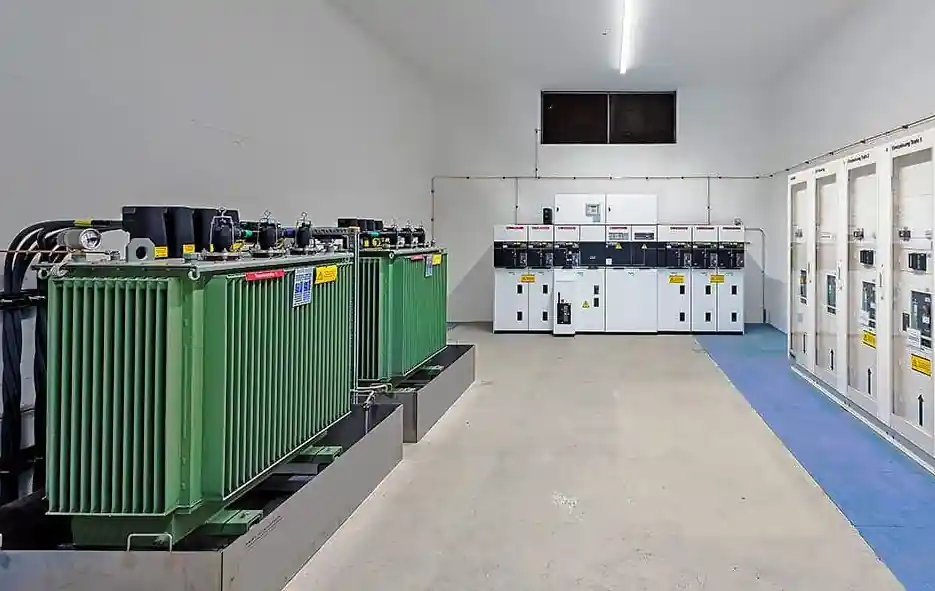In today’s expanding power networks, the MV to LV substation plays a pivotal role in delivering electricity safely and efficiently to end users. It serves as the vital interface where medium voltage (MV) electricity—typically distributed at levels between 1kV and 36kV—is stepped down to low voltage (LV), making it usable for homes, businesses, and industries.

Core Concept: What is an MV to LV Substation?
An MV to LV substation, also known as a distribution substation or secondary substation, is an electrical installation that transforms medium voltage (MV) power into low voltage (LV) electricity using step-down transformers. It includes protective equipment, control devices, and a layout designed to ensure reliability, safety, and accessibility.
Typical components include:
- MV Switchgear
- Power Transformer (typically 11kV/0.4kV or 33kV/0.4kV)
- LV Switchgear or Distribution Panel
- Protection Relays and Metering Units
Application Areas
MV to LV substations are essential in multiple sectors, including:
- Residential zones (apartment blocks, housing estates)
- Commercial areas (shopping centers, office buildings)
- Industrial parks (factories, logistics hubs)
- Infrastructure projects (airports, hospitals, ports)
- Renewable energy (solar PV plants, wind farms feeding LV networks)

Market Background and Industry Evolution
As per IEEE and IEEMA market data, the growing demand for electrification, urbanization, and decentralized energy systems has fueled the global deployment of MV to LV substations. These units are increasingly designed as prefabricated compact substations or kiosks, simplifying installation and reducing space requirements.
Recent trends include:
- Digital substations with remote monitoring
- Use of IEC 61850 communication protocols
- Integration with smart grid platforms
- Enhanced safety features including arc-flash mitigation
Key suppliers include ABB, Schneider Electric, PINEELE, and Siemens, offering modular, scalable, and IoT-ready designs.
Technical Parameters and System Overview
| Parameter | Typical Specification |
|---|---|
| Input Voltage (MV) | 11kV, 22kV, 33kV |
| Output Voltage (LV) | 400V (3-phase), 230V (single-phase) |
| Transformer Rating | 100kVA to 2500kVA |
| Cooling Type | Oil-immersed or Dry-type |
| Installation | Indoor or outdoor kiosk-type units |
| Standards Compliance | IEC 60076, IEC 62271, IEEE Std C57 |

Comparison with Other Substations
While all substations serve the role of voltage conversion and protection, MV to LV substations are specifically designed for distribution-level delivery, as opposed to transmission substations which operate at much higher voltages (110kV and above).
Key differences include:
- Smaller footprint
- Lower capacity transformers
- Direct connection to end-user distribution panels
- Higher emphasis on compactness and safety
Selection Guidance: Choosing the Right Substation
When selecting or designing an MV to LV substation, consider:
- Load demand: Total kVA capacity and peak load requirements
- Environmental conditions: Humidity, dust, temperature, corrosion
- Accessibility and location: Urban vs. remote, indoor vs. outdoor
- Maintenance access: Removable panels, remote diagnostics
- Standards compliance: Regional and project-specific regulations
Consulting technical handbooks from ABB, Schneider, and PINEELE is strongly recommended.
Frequently Asked Questions (FAQ)
A1: Yes. Properly rated substations can distribute power to entire neighborhoods or multi-building facilities via underground or overhead LV feeders.
A2: Compact substations integrate MV switchgear, transformer, and LV panel in a single unit. Traditional setups use separate rooms or enclosures for each component.
A3: Oil-type offers higher efficiency and cooling but requires stricter fire safety. Dry-type is safer for indoor and environmentally sensitive areas.
An MV to LV Compact Substation is not just a transformer station—it’s a critical component of reliable power delivery. By stepping down voltage levels efficiently and safely, it ensures that energy reaches its final destination without losses or hazards. Whether deployed in urban centers or industrial zones, these substations are the linchpins of modern low-voltage distribution networks.
To learn more, refer to detailed documentation from PINEELE, Wikipedia, ABB, and Schneider Electric for standards, case studies, and configuration guidelines.